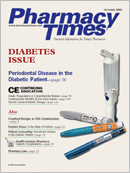Publication
Article
Pharmacy Times
GUEST COMMENTARY: FIGHTING THE NEW PHARMACOPHOBIA
Author(s):
Recent reports about the allegeddangers of certain prescriptiondrugs are testaments to the factthat we are at a critical point in the historyof drug development.
As an official of the pharmaceuticalindustry, the increasing numbers ofunsubstantiated and misleading newsstories and inflammatory headlinesabout prescription drugs discourage me.The industry must continue to combatthis misinformation by stating the factsplainly to set the record straight wheremisperception exists. Most importantly,we must continue to do what we havedone all along: maintain our unwaveringcommitment to patient safety andthe development of products that havea positive risk-benefit profile.
One critical area of misperception isthe safety of prescription drugs. In this"post-Vioxx era," there is a dangerouslydistorted public view that today'spharmaceuticals should not carry anyrisks and that the pharmaceuticalindustry, as a whole, has been less thanforthcoming in discussing the safetyprofile of its products.
Collecting evidence of the safety ofa drug is perhaps the most challengingaspect of drug development, involvingyears of study and thousands of hoursof patient experience prior to launch.At AstraZeneca, patient safety is ourtop priority. As part of one of the mostregulated industries in America, we arecommitted to and employ the highestsafety standards.
To determine a medicine's safetyprofile, tremendous resources must beinvested in clinical research. GoodClinical Practice (GCP) guides theindustry during the clinical developmentprocess. Compliance with GCPand consultation with IndependentReview Boards make up the cornerstoneof good clinical trial management.
Our researchers incorporate safetytesting throughout the clinical developmentprocess, by scrutinizing the availablepatient data in search of safety signalsto enhance each new medicine'ssafety profile. With the achievement ofeach additional drug-developmentmilestone, safety assessment becomeseven more rigorous, and safety-relatedinvestment increases. After a drug islaunched, a pharmaceutical companycontinues to monitor and investigateserious adverse events reported for itsmedicines. This process continues forthe life of every product that we market.For example, at AstraZeneca wedevelop risk management strategies,with the goal that the company's medicinesare used as safely as possible.
One of the challenges for the pharmaceuticalindustry these days is notonly how we practice drug safety, butalso how it is communicated. To ensurethat patients, physicians, and pharmacistsget the true picture of the safetyprofile of a product, you must take alook at the totality of its clinical data, asopposed to looking at a single source ofdata, to draw any definitive conclusions.Otherwise, inaccurate conclusionscan be made.
Crestor (rosuvastatin calcium) providesa timely example. Of all statintherapies available, Crestor was themost widely studied prior to launch,with more than 12,500 patients evaluatedin clinical trials. Since launch,Crestor has been part of a robust phase4 clinical trial program and has a rigorouspostmarketing safety program. Inaddition, the FDA conducts regularassessments of postmarketing safety surveillancedata for Crestor. In March2005, after a thorough review of all ofthe available Crestor data, the FDA statedthat the safety profile of Crestor issimilar to that of other marketed statins.(To view the full FDA response, pleasevisit www.fda.gov/cder/drug/infopage/rosuvastatin/crestor_CP.pdf.)
Yet, there are those who continueto interject flawed data analysis andmischaracterizations about pharmaceuticalproducts in the media. Doingso raises undue concern amongpatients—something that ultimatelycauses more potentially threateninghealth risks for patients, as medicationsare often stopped without consultinga health care provider. AtAstraZeneca, our goal is to ensure thatpatients and health care providers getan accurate picture of today's generationof products.
It is the shared responsibility of physicians,pharmacists, and all health careproviders to take strong steps to providepatients with important, accurate informationon the medicines available tothem. Even more important, health careproviders must play an active role inensuring that patients adhere to theirprescribed treatment plans.
We are at a critical point in the historyof drug development, where thepharmaceutical industry must act tocorrect the incorrect perceptions. It isimportant that we not only continue topractice what we preach, but that wealso truly preach about what we practice,so that patients and health careproviders know how serious the pharmaceuticalindustry is about its commitmentto patient safety.
Mr. Maldow is the director of professionalrelations for AstraZeneca Pharmaceuticals LPand a member of the Pharmacy Times Boardof Advisors.







